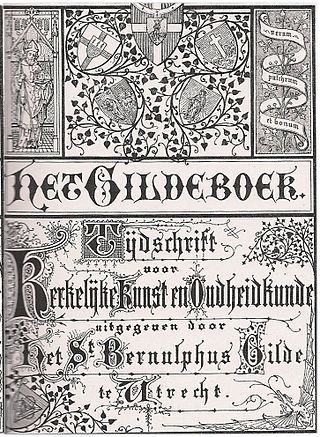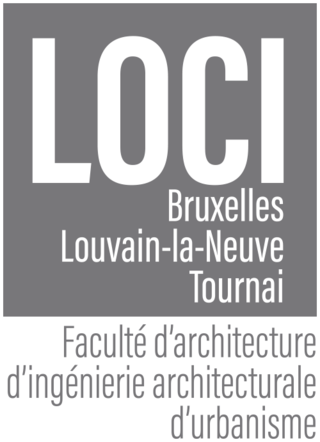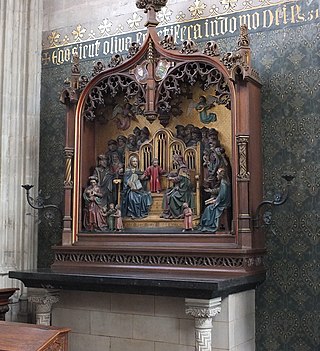Related Research Articles

Gerard David was an Early Netherlandish painter and manuscript illuminator known for his brilliant use of color. Only a bare outline of his life survives, although some facts are known. He may have been the Meester gheraet van brugghe who became a master of the Antwerp guild in 1515. He was very successful in his lifetime and probably ran two workshops, in Antwerp and Bruges. Like many painters of his period, his reputation diminished in the 17th century until he was rediscovered in the 19th century.

Jean-Baptiste Bethune was a Belgian architect, artisan and designer who played a pivotal role in the Belgian and Catholic Gothic Revival movement. He was called by some the "Pugin of Belgium", with reference to the influence on Bethune of the English Gothic Revival architect and designer, Augustus Pugin.

The Basilica of the Holy Blood is a Roman Catholic basilica in Bruges, Belgium. The church houses a relic of the Holy Blood allegedly collected by Joseph of Arimathea and brought from the Holy Land by Thierry of Alsace, Count of Flanders. Built between 1134 and 1157 as the chapel of the Count of Flanders, it was promoted to a minor basilica in 1923.

Henri Desclée (1830–1917) and Jules Desclée were Belgian brothers, known as founders of Maredsous Abbey, and of two printing business for Roman Catholic literature, the Société Saint-Jean l'Évangéliste and Desclée De Brouwer.

Lancelot Blondeel, also Lanceloot, was a Flemish artist active in Bruges. He worked as a painter, architect, city planner, surveyor and cartographer, and designed sculptures, tapestries and jewelry.

The St. Bernulphusgilde or Guild of St. Bernulphus was a Dutch Catholic secret society established on December 1, 1869. Its intention initially was to serve as a trade union and protect national traditions of old craftsmanship in religious art and church architecture. Information about the association's meetings, as well as trade information, was published in their magazine The Guild Book. The association was considered a guild and named after the 11th-century bishop of Utrecht, a passionate church builder named Bernold.
The Folklore of Belgium is extremely diverse and reflects the rich legacy of cultural and religious influences which have acted on the region throughout its history, even before the establishment of the nation of Belgium in 1830. Much of Belgian folklore is unique to the region in which it is commemorated. Many aspects of folklore are manifested in public processions and parades in Belgian cities; traditions which are kept alive for the amusement of locals and tourists alike.

William Henry James Weale was a British art historian who lived and worked most of his life in Bruges and was one of the first to research the Early Netherlandish painting extensively. He was also a pioneer in the study of early bookbinding, and a staunch promoter of Gothic Revival architecture.
Events in the year 1902 in Belgium.

Jan Baptist van Meunincxhove was a Flemish painter of cityscapes, architectural paintings, marine views and group portraits who was active in Bruges. Without being original, he maintained a high standard of painting at a time when art in Flanders was in decline.
Charles-Joseph Voisin (1802–1872) was a Belgian Catholic clergyman and art historian.
Arthur Théodore Verhaegen was a Gothic Revival Belgian architect and a politician of the Catholic Party, one of the founders of Belgian Christian democracy. He was a grandson of the politician and lawyer Pierre-Théodore Verhaegen.
Events in the year 1862 in Belgium.

The Faculty of Architecture, Architectural Engineering and Urban Planning, often called LOCI, is the 14th faculty of the University of Louvain, Belgium. It became an independent faculty in 2009, with the merger of three institutes founded between 1867 and 1882, and is active in Brussels (Saint-Gilles), Tournai and Louvain-la-Neuve.
The Malines Congresses were a series of Catholic Congresses held in Mechelen, Belgium, with the purpose of bringing together Catholics with leading roles in all walks of life, on the model of the German Katholikentage. The first three, held in 1863, 1864 and 1867, had considerable cultural, social and political impact. They lay at the foundation of the future development of a Catholic Party in Belgian politics, as well as a nascent Social Catholicism. The first congress saw the establishment of the Guild of Saint Thomas and Saint Luke, which shaped Belgian Gothic Revival architecture and art education. The main organiser of the first three congresses was Édouard Ducpétiaux, who died in 1868. They were hosted in Mechelen by the archbishop, Engelbert Sterckx, who died in December 1867, although much of the practical management fell to Isidore-Joseph du Rousseaux, a teacher at the junior seminary where many of the sessions were held.

Events in the year 1859 in Belgium.
Joris or Georges Helleputte was a Belgian politician and neo-Gothicist architect. He served as Minister of Agriculture and Public Works and Minister of Railways, Post and Telegraphs.

Benoît Van Uytvanck was a Belgian sculptor.
Alphonse Frédéric De Moerloose, born in Gentbrugge, Belgium, on 12 January 1858, died in Schilde, Belgium, on 27 March 1932 was a priest of the Congregation of the Immaculate Heart of Mary [CICM] and a Belgian architect. He was a missionary in China from 1885 to 1929 and built several Catholic churches in Inner Mongolia and North China.
References
- ↑ W. H. James Weale, Tableaux de l'ancienne école néerlandaise exposés à Bruges: catalogue (Bruges, 1867), on Google Books
- ↑ Jan De Maeyer, "Pro Arte Christiana: Catholic Art Guilds, Gothic Revival and the Cultural Identity of the Rhine-Meuse Region", in Historism and Cultural Identity in the Rhine-Meuse Region, edited by Wolfgang Cortjaens and Tom Verschaffel (Leuven, 2008), p. 163.
- ↑ Jan De Maeyer, Arthur Verhaegen, 1847-1917: De rode baron (Leuven University Press, 1994), p. 131.